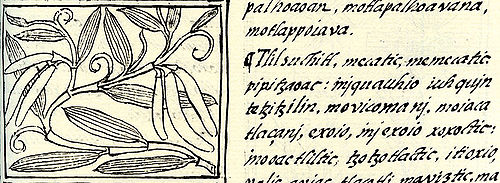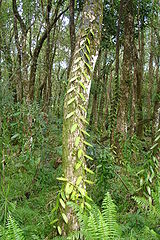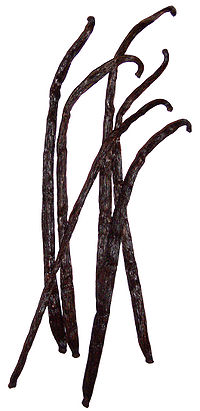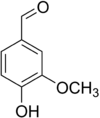
Vanilla
About this schools Wikipedia selection
SOS Children, an education charity, organised this selection. Sponsor a child to make a real difference.
Vanilla is a flavouring derived from orchids in the genus Vanilla native to Mexico. The name came from the Spanish word "vainilla," meaning "little pod."
Vanilla is valued for its sweet flavour and scent and is widely used in the preparation of desserts and perfumes. Today, the majority of the world's vanilla is produced in a small region of Madagascar, an island in the Indian Ocean off the eastern coast of Africa.
Vanilla orchid
The main species harvested for vanillin is Vanilla planifolia. Although it is native to Mexico, it is now widely grown throughout the tropics. Madagascar is the world's largest producer. Additional sources include Vanilla pompona and Vanilla tahitiensis (grown in Tahiti and Niue), although the vanillin content of these species is much less than Vanilla planifolia.
Vanilla grows as a vine, climbing up an existing tree (also called a tutor), pole, or other support. It can be grown in a wood (on trees), in a plantation (on trees or poles), or in a "shader", in increasing orders of productivity. Its growth environment is referred to as its terroir and includes not only the adjacent plants, but also the climate, geography and local geology. Left alone, it will grow as high as possible on the support, with few flowers. Every year, growers fold the higher parts of the plant downwards so that the plant stays at heights accessible by a standing human. This also greatly stimulates flowering.
The distinctively flavoured compounds are found in the fruit, which results from the pollination of the flower. One flower produces one fruit. Vanilla planifolia flowers are hermaphroditic: they carry both male ( anther) and female ( stigma) organs; however, to avoid self-pollination, a membrane separates those organs. The flowers can only be naturally pollinated by a specific Melipone bee found in Mexico (abeja de monte or mountain bee). This bee provided Mexico with a 300 year long monopoly on Vanilla production, from the time it was first discovered by Europeans and the French first transplanted the vines to their overseas colonies, until a substitute was found for the bees. The vines would grow, but would not fruit outside of Mexico. Growers tried to bring this bee into other growing locales, to no avail. The only way to produce fruits without the bees is artificial pollination. And today, even in Mexico, hand pollination is used extensively.
In 1836, botanist Charles François Antoine Morren was drinking coffee on a patio in Papantla (in Veracruz, Mexico) and noticed black bees flying around the vanilla flowers next to his table. He watched their actions closely as they would land and work their way under a flap inside the flower, transferring pollen in the process. Within hours the flowers closed and several days later Morren noticed vanilla pods beginning to form. Morren immediately began experimenting with hand pollination. A few years later in 1841, a simple and efficient artificial pollination method was developed by a 12-year-old slave named Edmond Albius on Réunion: a method still used today. Using a beveled sliver of bamboo, an agricultural worker lifts the membrane separating the anther and the stigma, then, using his thumb, transfers the pollen from the anther to the stigma. The flower, self-pollinated, will then produce a fruit. The vanilla flower lasts about one day, sometimes less, and so, growers have to inspect their plantations every day for open flowers, a labor-intensive task.
The fruit (a seed capsule), if left on the plant, will ripen and open at the end; as it dries, the phenolic compounds crystallize giving the beans a diamond-dusted appearance which the French call givre (hoarfrost). It will then release the distinctive vanilla smell. The fruit contains tiny, flavourless seeds. In dishes prepared with whole natural vanilla, these seeds are recognizable as black specks.
Like other orchids' seeds, vanilla seed will not germinate without the presence of certain mycorrhizal fungi. Instead, growers reproduce the plant by cutting: they remove sections of the vine with six or more leaf nodes, a root opposite each leaf. The two lower leaves are removed, and this area is buried in loose soil at the base of a support. The remaining upper roots will cling to the support, and often grow down into the soil. Growth is rapid under good conditions.
History
The first to cultivate vanilla were the Totonac people, who inhabit the Mazantla Valley on the Gulf Coast of Mexico in the present-day state of Veracruz. According to Totonac mythology, the tropical orchid was born when Princess Xanat, forbidden by her father from marrying a mortal, fled to the forest with her lover. The lovers were captured and beheaded. Where their blood touched the ground, the vine of the tropical orchid grew.

In the fifteenth century, Aztecs from the central highlands of Mexico conquered the Totonacs, and the conquerors soon developed a taste for the vanilla bean. They named the bean tlilxochitl, or "black flower", after the mature bean, which shrivels and turns black shortly after it is picked. After they were subjected to the Aztecs the Totonacs paid their tribute by sending vanilla beans to the Aztec capital, Tenochtitlan.
Vanilla was completely unknown in the Old World before Columbus. Spanish explorers who arrived on the Gulf Coast of Mexico in the early sixteenth century gave vanilla its name. The Spanish and Portuguese sailors and explorers brought vanilla into Africa and Asia in the 16th century. They called it vainilla, or "little pod", The word vanilla entered the English language in the 1754, when the botanist Philip Miller wrote about the genus in his Gardener’s Dictionary.
Until the mid-19th century, Mexico was the chief producer of vanilla. In 1819, however, French entrepreneurs shipped vanilla beans to the Réunion and Mauritius islands with the hope of producing vanilla there. After Edmond Albius, a 12-year-old slave from Réunion Island, discovered how to pollinate the flowers quickly by hand, the pods began to thrive. Soon the tropical orchids were sent from Réunion Island to the Comoros Islands and Madagascar along with instructions for pollinating them. By 1898, Madagascar, Réunion, and the Comoros Islands produced 200 metric tons of vanilla beans, about 80 percent of world production.
The market price of vanilla rose dramatically in the late 1970s, due to a typhoon. Prices stayed stable at this level through the early 1980s despite the pressure of recently introduced Indonesian vanilla. In the mid-1980s, the cartel that had controlled vanilla prices and distribution since its creation in 1930 disbanded. Prices dropped 70 percent over the next few years, to nearly US$20 per kilo. This changed, due to typhoon Huddah, which struck early in the year 2000. The typhoon, political instability, and poor weather in the third year drove vanilla prices to an astonishing US$500 per kilo in 2004, bringing new countries into the vanilla industry. A good crop, coupled with decreased demand caused by the production of imitation vanilla, have pushed the market price down to the $40 per kilo range in the middle of 2005.
Madagascar (mostly the fertile region of Sava) accounts for half of the global production of vanilla. Mexico, once the leading producer of natural vanilla with an annual 500 tons, produced only 10 tons of vanilla in 2006. An estimated 95% of “vanilla” products actually contain artificial vanillin, produced from lignin.
Chemistry
Though there are many compounds present in the extracts of vanilla, the compound vanillin (4-hydroxy-3-methoxybenzaldehyde) is primarily responsible for the characteristic flavour and smell of vanilla. Another minor component of vanilla essential oil is piperonal (heliotropin). Piperonal and other substances affect the odour of natural vanilla. Vanillin was first isolated from vanilla pods by Gobley in 1858. By 1874, it had been obtained from glycosides of pine tree sap, temporarily causing a depression in the natural vanilla industry.
Vanilla essence comes in two forms. Real seedpod extract is an extremely complicated mixture of several hundred different compounds. Synthetic essence, consisting basically of a solution of synthetic vanillin in ethanol, is derived from phenol and is of high purity.
General production guidelines
In general, good vanilla will only come from good vines. In order to achieve such high quality, a lot of labour has to be put into production. Commercial Vanilla production can be performed under open field and “Greenhouse” operations. Both production systems share the following similarities: - Plant height and number of years before producing the first grains - Shade necessities - Amount of organic matter needed - A tree or frame to grow around it (Bamboo, coconut or Erythrina lanceolata) - Labour intensity (pollination and harvest activities)
Vanilla grows best under hot humid climate from sea level to an elevation of 1500m. Most of its production is done 10 to 20 degrees above and below the equator. The ideal growing conditions are moderate rainfall 150-300cm evenly distributed through 10 months of the year. The optimum temperatures for cultivation are 60 to 90 F during the day and 60 to 70 F during the night. Ideal humidity is around 80% and under normal greenhouse condition it can be achieved by an evaporated cooler. However, since greenhouse Vanilla is grown near the equator and under polymer (HDPE) netting (Shading of 50%) this humidity is achieved by the RH of environment.
Soils for vanilla cultivation should be loose with high organic matter content and loamy texture. They must be well drained and a slight slope helps in this condition. Soil pH has not been well documented but some researchers have indicated an optimum soil pH of around 5.3 . Mulch is very important for proper growth of the vine and a considerable portion of mulch should be placed in the base of the vine. Fertilization varies with soil conditions but general recommendations are: 40 to 60g of N, 20 to 30g of P2O5 and 60 to 100g of K2O should be applied to each plant per year besides organic manures like vermicompost, oil cakes, poultry manure and wood ash. Foliar applications are also good for vanilla and a solution of 1% NPK (17:17:17) can be spray in the plant once a month. Vanilla likes a lot of organic matter; therefore 3 to 4 applications of mulch a year are adequate for the plant.
Propagation, Pre-plant preparation and Type of stock
Dissemination of vanilla can be achieved either by stem cutting or by tissue culture. For stem cutting a progeny garden needs to be established. Recommendations for establishing this garden vary, but in general trenches of 60cm in width and 45 cm in depth and 60 cm spacing for each plant is necessary. All plants need to grow under 50% shade as well as the rest of the crop. Mulching the trenches with coconut husk and micro irrigation provide ideal micro climate for vegetative growth. Cuttings between 60 and 120cm should be selected for planting in the field or greenhouse. Cuttings below 60 cm need to be rooted and raised in a separate nursery before planting. Planting material should always come from unflowered portions of the vine. Wilting of the cuttings before planting provides better conditions for root initiation and establishment.
Before planting the cuttings, trees that will support the vine must be planted at least three months before sowing the cuttings. Pits of 30 x 30 x 30 cm are dug 30 cm away from the three and field with FYM (farm yard manure) (or Vermicompost), sand and top soil mixed well. An average of 2000 cuttings can be planted per hectare. One important consideration is that when planting the cuttings from the base 4 leaves should be pruned and the pruned basal point must be pressed into the soil in a way that the 4 nodes are in close contact with the soil and are placed at a depth of 15 to 20cm. The top portion of the cutting is tied up to the tree using natural fibers like banana or hemp.
Tissue culture
Several methods have been proposed for vanilla tissue culture, but all of them begin from axillary buds of the vanilla vine. In vitro multiplication has also been achieved through culture of callus masses, protocorns, root tips and stem nodes. Description of any of these processes can be obtained from the references listed before, but all of them are successful in generation of new vanilla plants that first need to be grown up to a height of at least 30 cm before they can be planted in the field or greenhouse.
Scheduling considerations
In the tropics the ideal time for planting Vanilla is from September to November when the weather is neither to rainy or to dry; but this recommendation vary with growing conditions. Cuttings take 1 to 8 weeks to establish roots and show initial signs of growth from one of the leaf axils. A thick mulch of leaves should be provided immediately after planting as additional source of organic matter. From cuttings to produce flower and therefore pods it takes around three years. As with most orchids, the blossoms grow along stems branching from the main vine. The buds, growing along the 6 to 10 inch stems, bloom and mature in sequence, each at a different interval.
Pollination
Flowering normally occurs every spring and without pollination the blossom wilts and falls, and no vanilla bean can grow. Each flower must be hand-pollinated within 12 hours of opening. The only insect capable of pollinating the blossom is the Melipona, a bee, native only to Mexico. All vanilla grown today is pollinated by hand. A small splinter of wood or a grass stem is used to lift the rostellum or moved the flap upward so that the overhanging anther can be pressed against the stigma and self pollinate the vine. Generally one flower per raceme opens per day and therefore the raceme may be in flowering for over 20 days. A healthy vine should produce about 50 to 100 beans per year; however growers are careful to pollinate only 5 to 6 flowers from the 20 on each raceme. The first 5 to 6 flowers that open per vine should be pollinated so that the beans are similar in age. These agronomic practices facilitate harvest and increases bean quality. It takes the fruits to develop 5 to 6 weeks but it takes around 9 months for the bean to mature. Over pollination will result in diseased and inferior bean quality. A vine remains productive between 12 to 14 years.
Pest and disease management
Most of the diseases come from the uncharacteristic growing conditions of vanilla. Therefore conditions like excess water, insufficient drainage, heavy mulch, over pollination and too much shade favour disease development. Vanilla is susceptible to many fungal and viral diseases. Fusarium sp,Sclerotium sp, Phytopthora sp and Collectrotricum sp cause rots of root, stem, leaf, bean and shoot apex. These diseases can be controlled by spraying Bordeaux mixture (1%), Bavistin (0.2%) and Copper oxy chloride (0.2%).
Biological control of the spread of such diseases can be managed by applying to the soil Trichoderma (0.5 kg per plant in the rhizosphere) and foliar application of Pseudomonads (0.2%). Mosaic, leaf curl and Cymbidium mosaic potex virus are the common viral diseases. These diseases are transmitted through the sap; consequently affected plants have to be destroyed. The insect pests of vanilla include beetles and weevils which attack the flower, caterpillars, snakes and slugs that damage the tender parts of shoot, flower buds and immature beans and grass hoppers that affect cutting shoot tips. If organic agriculture is practiced, insecticides are avoided and mechanical measures are adopted for pest management. . Most of these practices are implemented under greenhouse cultivation since in the field such conditions are very difficult to achieve.
Stages of production

- Harvest
- The vanilla bean grows quickly on the vine but is not ready for harvest until maturity- approximately nine months. Harvesting vanilla beans is as labour intensive as pollinating the blossoms. Immature dark green pods are not harvested. Pale yellow discoloration which commences at the distal end of the beans is an indication of the maturity of pods. Each bean ripens at its own time, requiring a daily harvest. To ensure the finest flavor from every bean, each individual pod must be picked by hand just as it beginning to split on the end. Over mature beans are likely to split causing a reduction in market value. Its commercial value is fixed based on the length of the pod. If the bean is more than 15 cm in length it belongs to first quality product. If the beans are between 10 to 15 cm long pods are under second quality and beans less than 10 cm in length are under third quality. Each of the beans has a considerable amount of seeds inside the pod which are covered by a dark red liquid from which the vanilla essence is extracted. Vanilla bean yield depends on the care and management given to the hanging and fruiting vines. Any practice directed to stimulate aerial root production has a direct effect on vine productivity. A five year old vine can produce between 1.5 and 3 kg pods and this production can increase up to 6 kg after a few years. The harvested green beans can be commercialized as such or cured in order to get a better market price
- Curing
- Several methods exist in the market for curing vanilla; nevertheless all of them consist of four basic steps: a- killing, b- sweating, c-slow drying and d- conditioning of the beans.
- Killing
- The vegetative tissue of the vanilla pod is killed to prevent further growing. The method of killing varies, but may be accomplished by sun killing, oven killing, hot water killing, killing by scratching, or killing by freezing. Hot water killing consist in dipping the pods in hot water (63-65C) for three minutes to stop the vegetative growth of the pods and initiate enzymatic reactions responsible for the aroma.
- Sweating
- This method consists of wrapping the beans in woolen cloth in order to raise the temperature (45-65C, under high humidity) of the beans under sunlight conditions for one hour for up to 10 days. During this time the pods are stored in wooden boxes under air tight conditions during the night. Under these conditions the beans develop the characteristic vanilla flavor, aroma and colour. Its purpose is to allow enzymes to catalyze the reactions involved in generating the vanilla flavor and aroma.
- Drying
- To prevent rotting and to lock the aroma in the pods, the pods are dried. Often, pods are laid out in the sun during the mornings and returned to their boxes in the afternoons. When 25-30% of the pods' weight is moisture (as opposed to the 60-70% they began drying with) they have completed the curing process and will exhibit their fullest aromatic qualities. This reduction in moisture content is achieved by spreading the beans on a wooden rack in a room for three to four weeks.
- Conditioning of the bean
- This step is performed by storing the pods for a few months in closed boxes where the fragrance develops. The processed beans are sorted, graded, bundled and wrapped in paraffin paper and preserved for the development of desired bean qualities, especially flavour and aroma. The cured vanilla beans contain an average of 2.5 % vanillin.
- Grading
- Once fully cured, the vanilla is sorted by quality and graded.
Culinary uses
| Country | Production (tonnes) |
% |
|---|---|---|
| 6,200 | 59% | |
| 2,399 | 23% | |
| 1,000 | 10% | |
| 306 | ||
| 192 | ||
| 144 | ||
| 195 | ||
| 65 | ||
| 50 | ||
| 23 | ||
| 20 | ||
| 10 | ||
| 8 | ||
| 8 | ||
| 3 | ||
| Source: UN Food & Agriculture Organization |
||
There are three main commercial preparations of natural vanilla:
- whole pod
- powder (ground pods, kept pure or blended with sugar, starch or other ingredients)
- extract (in alcoholic solution)
Vanilla flavouring in food may be achieved by adding vanilla extract or by cooking vanilla pods in the liquid preparation. A stronger aroma may be attained if the pods are split in two, exposing more of the pod's surface area to the liquid. In this case, the pods' seeds are mixed into the preparation. Natural vanilla gives a brown or yellow colour to preparations, depending on the concentration.
Good quality vanilla has a strong aromatic flavour, but food with small amounts of low quality vanilla or artificial vanilla-like flavourings are far more common, since true vanilla is much more expensive.
A major use of vanilla is in flavouring ice cream. The most common flavour of ice cream is vanilla, and thus most people consider it to be the "default" flavour. By analogy, the term "vanilla" is sometimes used as a synonym for "plain". Although vanilla is a prized flavoring agent on its own, it is also used to enhance the flavor of other substances, to which its own flavor is often complementary, such as chocolate, custard, caramel, coffee etc.
The cosmetics industry uses vanilla to make perfume.
The food industry uses methyl and ethyl vanillin. Ethyl vanillin is more expensive, but has a stronger note. Cook's Illustrated ran several taste tests pitting vanilla against vanillin in baked goods and other applications, and to the consternation of the magazine editors, tasters could not differentiate the flavour of vanillin from vanilla; however, for the case of vanilla ice cream, natural vanilla won out.
Medicinal effects
In old medicinal literature, vanilla is described as an aphrodisiac and a remedy for fevers. These purported uses have never been scientifically proven, but it has been shown that vanilla does increase levels of catecholamines (including epinephrine, more commonly known as adrenaline), and as such can also be considered mildly addictive.
In an in-vitro test vanilla was able to block quorum sensing in bacteria. This is medically interesting because in many bacteria quorum sensing signals function as a switch for virulence. The microbes only become virulent when the signals indicate that they have the numbers to resist the host immune system response.
The essential oils of vanilla and vanillin are sometimes used in aromatherapy.
Specific types of vanilla
Bourbon vanilla or Bourbon-Madagascar vanilla, produced from Vanilla planifolia plants introduced from the Americas, is the term used for vanilla from Indian Ocean islands such as Madagascar, the Comoros, and Réunion, formerly the Île Bourbon.
Mexican vanilla, made from the native Vanilla planifolia, is produced in much less quantity and marketed as the vanilla from the land of its origin. Vanilla sold in tourist markets around Mexico is sometimes not actual vanilla extract, but is mixed with an extract of the tonka bean, which contains coumarin. Tonka bean extract smells and tastes like vanilla, but coumarin has been shown to cause liver damage in lab animals and is banned in the US by the Food and Drug Administration.
Tahitian vanilla is the name for vanilla from French Polynesia, made with Vanilla tahitiensis. This species is descended from V. plantifolia that was introduced to Tahiti before mutating into a distinct species.
The term French vanilla is not a type of vanilla, but is often used to designate preparations that have a strong vanilla aroma, and contain vanilla grains. The name originates from the French style of making ice cream custard base with vanilla pods, cream, and egg yolks. Alternatively, French vanilla is taken to refer to a vanilla-custard flavour. Syrup labelled as French vanilla may include custard, caramel or butterscotch flavours in addition to vanilla.








